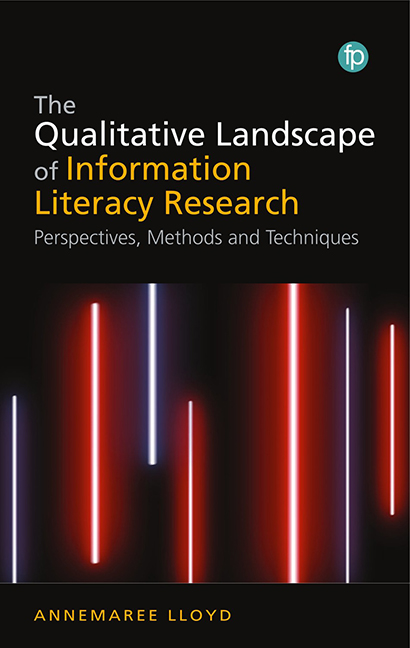Book contents
- Frontmatter
- Contents
- Figures
- Foreword
- Acknowledgements
- Introduction: The Qualitative Landscape of Information Literacy Research
- Chapter 1 Situating Information Literacy Research
- Chapter 2 Informing Information Literacy Research
- Chapter 3 Framing Information Literacy as an Educational Practice for Research. Learning Theories and Models
- Chapter 4 Qualitative Methods in Information Literacy Research
- Chapter 5 Collecting Data About Information Literacy: Data Collection Techniques
- Chapter 6 Planning for Research
- Chapter 7 Qualitatively Speaking and Doing Information Literacy Research
- References
- Index
Chapter 5 - Collecting Data About Information Literacy: Data Collection Techniques
Published online by Cambridge University Press: 21 October 2021
- Frontmatter
- Contents
- Figures
- Foreword
- Acknowledgements
- Introduction: The Qualitative Landscape of Information Literacy Research
- Chapter 1 Situating Information Literacy Research
- Chapter 2 Informing Information Literacy Research
- Chapter 3 Framing Information Literacy as an Educational Practice for Research. Learning Theories and Models
- Chapter 4 Qualitative Methods in Information Literacy Research
- Chapter 5 Collecting Data About Information Literacy: Data Collection Techniques
- Chapter 6 Planning for Research
- Chapter 7 Qualitatively Speaking and Doing Information Literacy Research
- References
- Index
Summary
Introduction
To investigate, discover or interrogate the practice or practising of information literacy requires a suite of data collection techniques that focus on how the practice is shaped in relation to the actions and activities that people engage with to connect with information in their specific setting. Decisions about data collection and what to collect are informed by methodology (method and research design, see Figure 1.5, p. 12). It is useful to remember that despite the particular qualitative method that is selected, techniques for data collection can be varied and decisions about what techniques to apply might depend on context, situation or topic rather than favour a particular method.
In this chapter, the term technique is used in preference to the broader term method, while also acknowledging that there is often a lack of distinction between the two terms, which are often used interchangeably. Methods (discussed in Chapter 4) represent a process or procedures for doing something (e.g. doing ethnography, critical incidence, phenomenography, doing constructivist grounded theory), while techniques are the practical aspects that enable that ‘doing’. Methods such as grounded theory method or phenomenography have the potential to use a variety of techniques which can be applied to the collection of data (e.g. semi-structured interviews or photography). In general, the selection and application of data collection techniques may be subject to the traditions of the research approach or method, resulting in different points of departure relative to the intentions of the research.This distinction between technique and method is also made by Pickard (2013), who provides an example in relation to the terms survey and questionnaire which are often used interchangeably (Pickard, 2013, xix) but are misleading, because a survey can also include other techniques apart from a questionnaire. The term ‘survey’, in Pickard's example, refers to a method.
In this chapter, core qualitative techniques that are often used in information literacy research are described, with the caveat that the techniques described do not represent an exhaustive list. As more research is conducted across the modalities of information literacy (social, epistemic and corporeal), more techniques and innovative ways of collecting data will be employed, e.g. techniques drawn or influenced by arts-informed research.
- Type
- Chapter
- Information
- The Qualitative Landscape of Information Literacy ResearchPerspectives, Methods and Techniques, pp. 79 - 96Publisher: FacetPrint publication year: 2021



